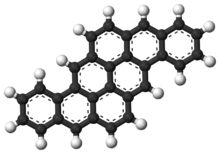Chemistry:Pyranthrene (molecule)

| |

| |
| Identifiers | |
|---|---|
3D model (JSmol)
|
|
| 1915988 | |
| ChEBI | |
| ChemSpider | |
| EC Number |
|
PubChem CID
|
|
| UNII | |
| |
| |
| Properties | |
| C30H16 | |
| Molar mass | 376.458 g/mol |
| Appearance | reddish-brown or yellowish |
| Density | 1.4±0.1 g/cm3 |
Except where otherwise noted, data are given for materials in their standard state (at 25 °C [77 °F], 100 kPa). | |
| Infobox references | |
Pyranthrene is a molecule with the chemical formula C
30H
16.[1]
Properties
Pyranthene is made up of eight benzene rings fused together, which classes it as a polycyclic aromatic hydrocarbon.[1]
It has a reddish-brown color, but turns to a yellowish color when it is purified via sublimation. The difference between these two forms of the molecule comes from the difference in the degrees of their crystallinity. The brown form of pyranthrene forms more perfect crystallites than the yellow form does.[2]
Pyranthrene is also an organic semiconductor. It displays photoconductive properties when it is in a solid state,[3] as well as when it is dissolved in a benzene solution.[4]
It has a density of 1.4±0.1 g/cm3.[5]
Uses
Pyranthrene has potential uses as a material used to make light-emitting diodes and solar cells.[6]
In addition, it has photophysical properties that allow it to be useful for biological imaging and sensing. However, pyranthrene has been shown to cause oxidative stress and DNA damage within cells,[6] and is classed as a carcinogen and an endocrine disruptor, which heavily limits its use in biological systems.[7]
Synthesis
Pyranthrene can be synthesized by reducing pyranthrone with zinc dust, acetic acid, and pyridine.[8]
References
- ↑ 1.0 1.1 National Center for Biotechnology Information (2023).. "PubChem Compound Summary for CID 67447, Pyranthrene." (in en). https://pubchem.ncbi.nlm.nih.gov/compound/67447.
- ↑ Mizuka, Sano; Hideo, Akamatu (August 22, 1963). "Semiconductivity and Color of Pyranthrene" (in en). Bulletin of the Chemical Society of Japan 36 (12): 1695–1696. doi:10.1246/bcsj.36.1695. ISSN 0009-2673.
- ↑ Inokuchi, Hiroo (August 29, 1953). "Photoconductivity of the Condensed Polynuclear Aromatic Compunds". Bulletin of the Chemical Society of Japan 27 (1): 22, 27. doi:10.1246/bcsj.27.22. https://www.journal.csj.jp/doi/abs/10.1246/bcsj.27.22.
- ↑ Mizuka, Sano; Hideo, Akamatu (December 17, 1962). "Photoconductivity in an Organic Liquid Solution". Bulletin of the Chemical Society of Japan 36 (4): 481. doi:10.1246/bcsj.36.480. https://www.journal.csj.jp/doi/pdf/10.1246/bcsj.36.480.
- ↑ "Pyranthrene | C30H16 | ChemSpider". http://www.chemspider.com/Chemical-Structure.60772.html.
- ↑ 6.0 6.1 "Buy Pyranthrene - 191-13-9 | BenchChem". https://www.benchchem.com/product/b089552.
- ↑ "pyranthrene (CHEBI:33159)". https://www.ebi.ac.uk/chebi/searchId.do?chebiId=CHEBI:33159.
- ↑ Susumu, Doi; Akiyoshi, Fujita; Shigeo, Ikeura; Tamotsu, Inabe; Yoshio, Matsunaga (February 13, 1979). "Electrical Properties and Constitution of Several Low-resistivity Iodine Complexes". Bulletin of the Chemical Society of Japan 52 (9): 2495. doi:10.1246/bcsj.52.2494. https://www.journal.csj.jp/doi/epdf/10.1246/bcsj.52.2494.
 |

